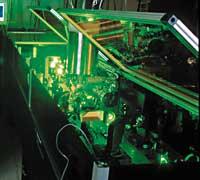What is inside the laser?

Austrian and German physicists have measured the frequency of the pulses within the laser. In short, the laser light is only an oscillating electromagnetic field, a succession of pulses of light that oscillates a thousand billion times in a second approximately. Physicists have wanted to know exactly what that estimate is.
For this purpose they have used another laser of higher frequency and neon gas. This second laser allows to release electrons from neon atoms at a very high frequency, since the electron beams were very short, much shorter than the oscillations of the area they wanted to measure. Therefore, the acceleration of these electrons in the area of the first laser allows its use to accurately measure the frequency and energy of the area.
The method has given a lot of precision to measure the frequency; now physicists know that the pulse occurs every 4.3 femtosegudas (one femtosecond is one billion a second). However, the measurement method itself is more important than the results, as it can show what exactly is within a laser.





